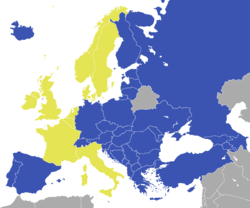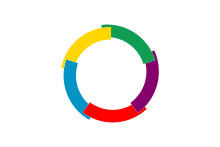Czech Republic
| Czech Republic |
||||||
|---|---|---|---|---|---|---|
|
||||||
| Motto: "Pravda vítězí" (Czech) "Truth prevails" |
||||||
Anthem:
|
||||||
![Location of the Czech Republic (dark green)– in Europe (green & dark grey)– in the European Union (green) – [Legend]](../I/m/EU-Czech_Republic.svg.png) Location of the Czech Republic (dark green) – in Europe (green & dark grey) |
||||||
| Capital and largest city | Prague 50°05′N 14°28′E / 50.083°N 14.467°E | |||||
| Official language | Czech[1] | |||||
| Officially recognised[2][3] | ||||||
| Ethnic groups (2014[4]) | ||||||
| Religion |
|
|||||
| Demonym | Czech | |||||
| Government | Unitary parliamentary constitutional republic |
|||||
| - | President | Miloš Zeman | ||||
| - | Prime Minister | Bohuslav Sobotka | ||||
| Legislature | Parliament | |||||
| - | Upper house | Senate | ||||
| - | Lower house | Chamber of Deputies | ||||
| Formation | ||||||
| - | Duchy of Bohemia | c. 870 | ||||
| - | Kingdom of Bohemia | 1198 | ||||
| - | Czechoslovakia | 28 October 1918 | ||||
| - | Czech Socialist Republic | 1 January 1969 | ||||
| - | Czech Republic | 1 January 1993 | ||||
| - | Joined the European Union | 1 May 2004 | ||||
| Area | ||||||
| - | Total | 78,866 km2 (116th) 30,450 sq mi |
||||
| - | Water (%) | 2 | ||||
| Population | ||||||
| - | Sep 2014 estimate | 10,538,275[5] (81st) | ||||
| - | 2011 census | 10,436,560[6] | ||||
| - | Density | 134/km2 (84th) 341/sq mi |
||||
| GDP (PPP) | 2015 estimate | |||||
| - | Total | $325.285 billion[7] (50th) | ||||
| - | Per capita | $30,895[7] (39th) | ||||
| GDP (nominal) | 2015 estimate | |||||
| - | Total | $180.789 billion[7] (49th) | ||||
| - | Per capita | $17,171[7] (41st) | ||||
| Gini (2012) | 24.9[8] low |
|||||
| HDI (2013) | very high · 28th |
|||||
| Currency | Czech koruna (CZK) | |||||
| Time zone | CET (UTC+1) | |||||
| - | Summer (DST) | CEST (UTC+2) | ||||
| Drives on the | right | |||||
| Calling code | +420b | |||||
| Patron saint | St Wenceslaus | |||||
| ISO 3166 code | CZ | |||||
| Internet TLD | .czc | |||||
| a. | The question is rhetorical, implying "those places where my homeland lies". | |||||
| b. | Code 42 was shared with Slovakia until 1997. | |||||
| c. | Also .eu, shared with other European Union member states. | |||||
The Czech Republic (![]() i/ˈtʃɛk rɨˈpʌblɪk/ CHEK-rə-PUB-lik;[10] Czech: Česká republika [ˈt͡ʃɛskaː ˈrɛpuˌblɪka]), is a landlocked country in Central Europe bordered by Germany to the west, Austria to the south, Slovakia to the southeast and Poland to the northeast. Prague, the capital, is the largest city, with 1.3 million residents. The Czech Republic includes the historical territories of Bohemia and Moravia, and Czech Silesia.
i/ˈtʃɛk rɨˈpʌblɪk/ CHEK-rə-PUB-lik;[10] Czech: Česká republika [ˈt͡ʃɛskaː ˈrɛpuˌblɪka]), is a landlocked country in Central Europe bordered by Germany to the west, Austria to the south, Slovakia to the southeast and Poland to the northeast. Prague, the capital, is the largest city, with 1.3 million residents. The Czech Republic includes the historical territories of Bohemia and Moravia, and Czech Silesia.
The Czech state was formed in the late 9th century as the Duchy of Bohemia under the Great Moravian Empire. After the fall of the Empire in 907, the centre of power transferred from Moravia to Bohemia under the Přemyslids. In 1004, the duchy was formally recognized as part of the Holy Roman Empire,[11][12] becoming the Kingdom of Bohemia in 1212, and reaching its greatest territorial extent in the 14th century. The King of Bohemia ruled not only Bohemia itself, but also other lands, which together formed the so-called Crown of Bohemia, and he had a vote in the election of the Holy Roman Emperor. In the Hussite wars of the 15th century driven by the Bohemian Reformation, the kingdom faced economic embargoes and defeated five crusades proclaimed by the leaders of the Roman Catholic Church and organized mainly by the emperor and princes of the Holy Roman Empire.
Following the Battle of Mohács in 1526, the whole Crown of Bohemia was gradually integrated into the Habsburg Monarchy alongside the Archduchy of Austria and the Kingdom of Hungary. The Bohemian Revolt (1618–20) against the Catholic Habsburgs led to the Thirty Years' War, after which the monarchy consolidated its rule, reimposed Catholicism, and adopted a policy of gradual Germanization. With the dissolution of the Holy Roman Empire in 1806, the Bohemian Kingdom became part of the Austrian Empire. In the 19th century, the Czech lands became the industrial powerhouse of the monarchy and were subsequently the core of the Republic of Czechoslovakia, which was formed in 1918 following the collapse of the Austro-Hungarian Empire after World War I.
Czechoslovakia was occupied by Germany in World War II, and was liberated in 1945 by Soviet and American forces. Most of the German-speaking inhabitants were expelled after the war and thus the country lost its sizeable minority and its bilingual character. The Communist Party of Czechoslovakia won the 1946 elections. Following the 1948 coup d'état, Czechoslovakia became a single-party communist state under Soviet influence. In 1968, increasing dissatisfaction with the regime culminated in a reform movement known as the Prague Spring, which ended in a Soviet-led invasion. Czechoslovakia remained occupied until the 1989 Velvet Revolution, when the communist regime collapsed and a multiparty parliamentary republic was formed. On 1 January 1993, Czechoslovakia peacefully dissolved, with its constituent states becoming the independent states of the Czech Republic and Slovakia.
The Czech Republic is a developed country[13] with an advanced,[14] high income economy[15] and high living standards.[16][17][18] The UNDP ranks the country 15th in inequality-adjusted human development.[19] The Czech Republic also ranks as the 11th most peaceful country, while achieving strong performance in democratic governance. It is a member of the European Union, NATO, the OECD, the OSCE and the Council of Europe.
Etymology
The traditional English name "Bohemia" derives from Latin "Boiohaemum", which means "home of the Boii". The current name comes from the endonym Čech, borrowed through Polish and spelled accordingly.[20][21] The name comes from the Slavic tribe (Czechs, Czech: Čechové) and, according to legend, their leader Čech, who brought them to Bohemia, to settle on Říp Mountain. The etymology of the word Čech can be traced back to the Proto-Slavic root *čel-, meaning "member of the people; kinsman", thus making it cognate to the Czech word člověk (a person).[22]
The country has been traditionally divided into three lands, namely Bohemia (Čechy) in the west, Moravia (Morava) in the southeast, and Czech Silesia (Slezsko; the smaller, south-eastern part of historical Silesia, most of which is located within modern Poland) in the northeast. Known officially as the "Lands of the Bohemian Crown" since the 14th century, a number of other names for the country have been used, including Czech/Bohemian lands, Bohemian Crown, and the Lands of the Crown of Saint Wenceslas. When the country regained its independence after the dissolution of the Austro-Hungarian empire in 1918, the new name of Czechoslovakia was coined to reflect the union of the Czech and Slovak nations within the one country.
Following the dissolution of Czechoslovakia at the end of 1992, the Czech part of the former nation found itself without a common single-word name in English. In 1993, the Czech Minister of Foreign Affairs Jozef Zieleniec suggested referring to the new country in less formal contexts as "Czechland", singling it out as a traditional name of the dominion of the Czechs.[23] He also offered the alternative "Czechia" /ˈtʃɛkiə/ (Česko Czech pronunciation: [ˈtʃɛsko] in Czech); while the Czech form has gained usage, the English version is still rare.[24] The current Czech president Miloš Zeman uses the name Czechia in his official speeches and promotes its wider use.[25][26][27] Nevertheless, in official documents and the full names of government institutions the term Czech Republic is always used.
History
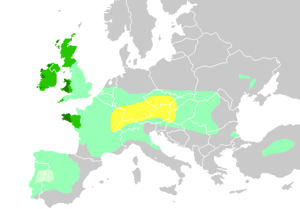
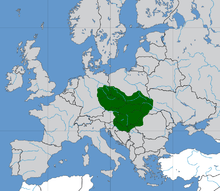
Prehistory
Archaeologists have found evidence of prehistoric human settlements in the area, dating back to the Paleolithic era. The figurine Venus of Dolní Věstonice found here is the oldest known ceramic article in the world.
In the classical era, from the 3rd century BC Celtic migrations, the Boii and later in the 1st century, Germanic tribes of Marcomanni and Quadi settled there. Their king Maroboduus is the first documented ruler of Bohemia. During the Migration Period around the 5th century, many Germanic tribes moved westwards and southwards out of Central Europe.
Slavic people from the Black Sea-Carpathian region settled in the area (a movement that was also stimulated by the onslaught of peoples from Siberia and Eastern Europe: Huns, Avars, Bulgars and Magyars). In the sixth century they moved westwards into Bohemia, Moravia and some of present day Austria and Germany. During the 7th century, the Frankish merchant Samo, supporting the Slavs fighting their Avar rulers, became the ruler of the first known Slav state in Central Europe. The Moravian principality arose in the 8th century and reached its zenith in the 9th, when it held off the influence of the Franks and won the protection of the Pope.
Bohemia
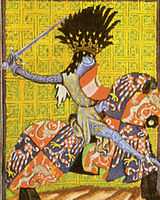
The Duchy of Bohemia emerged in the late 9th century, when it was unified by the Přemyslid dynasty. In 10th century Boleslaus I, Duke of Bohemia conquered Moravia, Silesia and expanded farther to the east. The Kingdom of Bohemia was, as the only kingdom in the Holy Roman Empire, a significant regional power during the Middle Ages. It was part of the Empire from 1002 till 1806, with the exception of the years 1440–1526. In 1212, King Přemysl Ottokar I (bearing the title "king" since 1198) extracted the Golden Bull of Sicily (a formal edict) from the emperor, confirming Ottokar and his descendants' royal status; the Duchy of Bohemia was raised to a Kingdom. The bull declared that the King of Bohemia would be exempt from all future obligations to the Holy Roman Empire except for participation in imperial councils. German immigrants settled in the Bohemian periphery in the 13th century. Germans populated towns and mining districts and, in some cases, formed German colonies in the interior of Bohemia. In 1235, the Mongols launched an invasion of Europe. After the Battle of Legnica, the Mongols carried their raids into Moravia. The Mongols subsequently invaded and defeated Hungary.[29]
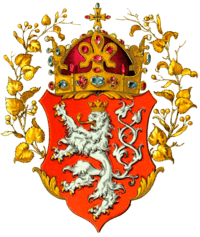
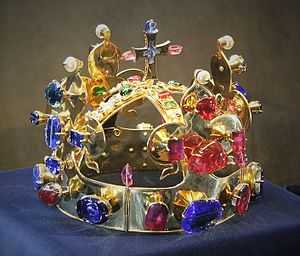
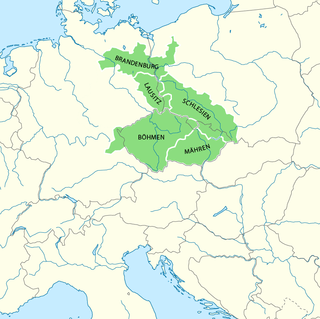
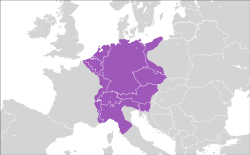
King Přemysl Ottokar II earned the nickname "Iron and Golden King" because of his military power and wealth. He acquired Austria, Styria, Carinthia and Carniola, thus spreading the Bohemian territory to the Adriatic Sea. He met his death at the Battle on the Marchfeld in 1278 in a war with his rival, King Rudolph I of Germany.[30] Ottokar's son Wenceslaus II acquired the Polish crown in 1300 for himself and the Hungarian crown for his son. He built a great empire stretching from the Danube river to the Baltic Sea. In 1306, the last king of Přemyslid line was murdered in mysterious circumstances in Olomouc while he was resting. After a series of dynastic wars, the House of Luxembourg gained the Bohemian throne.[31]
The 14th century, in particular, the reign of the Czech king Charles IV (1316–1378), who also became the King of Italy, King of the Romans and Holy Roman Emperor, is considered the Golden Age of Czech history. Of particular significance was the founding of Charles University in Prague in 1348, Charles Bridge, Charles Square. Much of Prague Castle and the cathedral of Saint Vitus in Gothic style were completed during his reign. He unified Brandenburg (until 1415), Lusatia (until 1635), and Silesia (until 1742) under the Czech crown. The Black Death, which had raged in Europe from 1347 to 1352, decimated the Kingdom of Bohemia in 1380,[32] killing about 10% of the population.[33]
By the end of the 14th century started the process of the so-called Bohemian (Czech) Reformation. The religious and social reformer Jan Hus formed a reform movement later named after him. Although Hus was named a heretic and burnt in Constance in 1415, his followers seceded from the Catholic Church and in the Hussite Wars (1419–1434) defeated five crusades organized against them by the Holy Roman Emperor Sigismund. Petr Chelčický continued with the Czech (Bohemian) Hussite Reformation movement. During the next two centuries, 90% of the inhabitants became adherents of the Hussite Christian movement.
After 1526 Bohemia came increasingly under Habsburg control as the Habsburgs became first the elected and then in 1627 the hereditary rulers of Bohemia. The Austrian Habsburgs of the 16th century, the founders of the central European Habsburg Monarchy, were buried in Prague. Between 1583–1611 Prague was the official seat of the Holy Roman Emperor Rudolf II and his court.
The Defenestration of Prague and subsequent revolt against the Habsburgs in 1618 marked the start of the Thirty Years' War, which quickly spread throughout Central Europe. In 1620, the rebellion in Bohemia was crushed at the Battle of White Mountain, and the ties between Bohemia and the Habsburgs' hereditary lands in Austria were strengthened. The war had a devastating effect on the local population; the people had to either convert to Catholicism or leave the country – otherwise they would be killed for heresy.
The following period, from 1620 to the late 18th century, has often been called colloquially the "Dark Age". The population of the Czech lands declined by a third through the expulsion of Czech Protestants as well as due to the war, disease and famine.[34] The Habsburgs prohibited all religions other than Catholicism, which was expressed by baroque architecture.[35] The flowering of baroque culture shows the ambiguity of this historical period. Ottoman Turks and Tatars invaded Moravia in 1663.[36] In 1679–1680 the Czech lands faced a devastating plague and an uprising of serfs.[37]
The reigns of Maria Theresa of Austria and her son Joseph II, Holy Roman Emperor and co-regent from 1765, were characterized by enlightened absolutism. In 1742, most of Silesia (except the southernmost area), at that time the possession of the Bohemian crown, was seized by King Frederick II of Prussia in the Silesian Wars. In 1757 the Prussians invaded Bohemia and after the Battle of Prague (1757) occupied the city. More than one quarter of Prague was destroyed and St. Vitus Cathedral also suffered heavy damage. However, soon after, at the Battle of Kolín Frederick was defeated and had to leave Prague and retreat from Bohemia. In 1770 and 1771 Great Famine killed about one tenth of the Czech population, or 250,000 inhabitants, and radicalised the countryside leading to peasant uprisings.[38]
After the fall of the Holy Roman Empire, Bohemia became part of the Austrian Empire and later of Austria–Hungary. Serfdom was abolished (in two steps) between 1781 and 1848.
Czechoslovakia
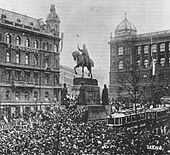
An estimated 1.4 million Czech soldiers fought in World War I, of whom some 150,000 died. More than 90,000 Czech volunteers formed the Czechoslovak Legions in France, Italy and Russia, where they fought against the Central Powers and later against Bolshevik troops.[39] In 1918, during the collapse of the Habsburg Empire at the end of World War I, the independent republic of Czechoslovakia, which joined the winning Allied powers, was created. This new country incorporated the Bohemian Crown (Bohemia, Moravia and Silesia) and parts of the Kingdom of Hungary (Slovakia and the Carpathian Ruthenia) with significant German, Hungarian, Polish and Ruthenian speaking minorities.[40]
In 1929 compared to 1913, the gross domestic product increased by 52% and industrial production by 41%. In 1938 Czechoslovakia held a 10th place in the world industrial production.[41]
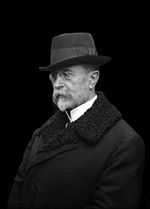
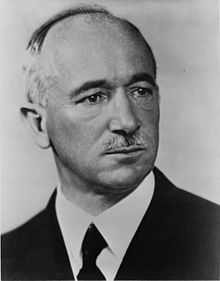
Although Czechoslovakia was a unitary state, it provided what were at the time rather extensive rights to its minorities and remained the only democracy in this part of Europe in the interwar period. The effects of the Great Depression including high unemployment and massive propaganda from Nazi Germany, however, resulted in discontent and strong support among ethnic Germans for a break from Czechoslovakia.
Adolf Hitler took advantage of this opportunity and, using Konrad Henlein's separatist Sudeten German Party, gained the largely German speaking Sudetenland (and its substantial Maginot Line-like border fortifications) through the 1938 Munich Agreement (signed by Nazi Germany, France, Britain and Italy). Czechoslovakia was not invited to the conference and felt betrayed by the United Kingdom and France, so Czechs and Slovaks call the Munich Agreement the Munich Betrayal because the military alliance Czechoslovakia had with France proved useless.
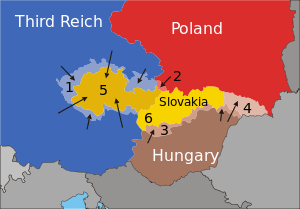
Despite the mobilization of 1.2 million-strong Czechoslovak army and the Franco-Czech military alliance, Poland annexed the Zaolzie area around Český Těšín; Hungary gained parts of Slovakia and the Subcarpathian Rus as a result of the First Vienna Award in November 1938. The remainders of Slovakia and the Subcarpathian Rus gained greater autonomy, with the state renamed to "Czecho-Slovakia". After Nazi Germany threatened to annex part of Slovakia, allowing the remaining regions to be partitioned by Hungary and Poland, Slovakia chose to maintain its national and territorial integrity, seceding from Czecho-Slovakia in March 1939, and allying itself, as demanded by Germany, with Hitler's coalition.[42]
The remaining Czech territory was occupied by Germany, which transformed it into the so-called Protectorate of Bohemia and Moravia. The protectorate was proclaimed part of the Third Reich, and the president and prime minister were subordinated to the Nazi Germany's Reichsprotektor. Subcarpathian Rus declared independence as the Republic of Carpatho-Ukraine on 15 March 1939 but was invaded by Hungary the same day and formally annexed the next day. Approximately 345,000 Czechoslovak citizens, including 277,000 Jews, were killed or executed while hundreds of thousands of others were sent to prisons and Nazi concentration camps or used as forced labour. Up to two-thirds of the citizens were in groups targeted by the Nazis for deportation or death.[43] One concentration camp was located within the Czech territory at Terezín, north of Prague.
There was some Czech resistance to Nazi occupation, both at home and abroad, most notably with the assassination of Nazi German leader Reinhard Heydrich by Czechoslovakian soldiers Jozef Gabčík and Jan Kubiš in a Prague suburb on 27 May 1942. The Czechoslovak government-in-exile and its army fought against the Germans and were acknowledged by the Allies; Czech/Czechoslovak troops fought from the very beginning of the war in Poland, France, the UK, North Africa, the Middle East and the Soviet Union. The German occupation ended on 9 May 1945, with the arrival of the Soviet and American armies and the Prague uprising. An estimated 140,000 Soviet soldiers died in liberating Czechoslovakia from German rule.[44]
In 1945–1946, almost the entire German-speaking minority in Czechoslovakia, about 3 million people, were expelled to Germany and Austria. During this time, thousands of Germans were held in prisons and detention camps or used as forced labour. In the summer of 1945, there were several massacres. The only Germans not expelled were some 250,000 who had been active in the resistance against the Nazi Germans or were considered economically important, though many of these emigrated later. Following a Soviet-organised referendum, the Subcarpathian Rus never returned under Czechoslovak rule but became part of the Ukrainian Soviet Socialist Republic, as the Zakarpattia Oblast in 1946.
Czechoslovakia uneasily tried to play the role of a "bridge" between the West and East. However, the Communist Party of Czechoslovakia rapidly increased in popularity, with a general disillusionment with the West, because of the pre-war Munich Agreement, and a favourable popular attitude towards the Soviet Union, because of the Soviets' role in liberating Czechoslovakia from German rule. In the 1946 elections, the Communists gained 38%[45] of the votes and became the largest party in the Czechoslovak parliament. They formed a coalition government with other parties of the National Front and moved quickly to consolidate power. A significant change came in 1948 with coup d'état by the Communist Party. The Communist People's Militias secured control of key locations in Prague, and a single party government was formed.
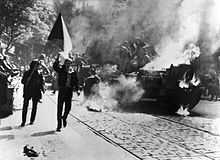
For the next 41 years, Czechoslovakia was a Communist state within the Eastern Bloc. This period is characterized by lagging behind the West in almost every aspect of social and economic development. The country's GDP per capita fell from the level of neighboring Austria below that of Greece or Portugal in the 1980s. The Communist government completely nationalized the means of production and established a command economy. The economy grew rapidly during the 1950s but slowed down in the 1960s and 1970s and stagnated in the 1980s. The political climate was highly repressive during the 1950s, including numerous show trials and hundreds of thousands of political prisoners, but became more open and tolerant in the late 1960s, culminating in Alexander Dubček's leadership in the 1968 Prague Spring, which tried to create "socialism with a human face" and perhaps even introduce political pluralism. This was forcibly ended by invasion by all Warsaw Pact member countries with the exception of Romania and Albania on 21 August 1968.
The invasion was followed by a harsh program of "Normalization" in the late 1960s and the 1970s. Until 1989, the political establishment relied on censorship of the opposition. Dissidents published Charter 77 in 1977, and the first of a new wave of protests were seen in 1988. Between 1948 and 1989 more than 250,000 Czechs and Slovaks were sent to prison, and over 400,000 emigrated.[46]
Velvet Revolution and independence
In November 1989, Czechoslovakia returned to a liberal democracy through the peaceful "Velvet Revolution". However, Slovak national aspirations strengthened and on 1 January 1993, the country peacefully split into the independent Czech Republic and Slovakia. Both countries went through economic reforms and privatisations, with the intention of creating a market economy. This process was largely successful; in 2006 the Czech Republic was recognised by the World Bank as a "developed country",[13] and in 2009 the Human Development Index ranked it as a nation of "Very High Human Development".[47]
.jpg)
From 1991, the Czech Republic, originally as part of Czechoslovakia and since 1993 in its own right, has been a member of the Visegrád Group and from 1995, the OECD. The Czech Republic joined NATO on 12 March 1999 and the European Union on 1 May 2004. On 21 December 2007 the Czech Republic joined the Schengen Area. It held the Presidency of the European Union for the first half of 2009.
Government
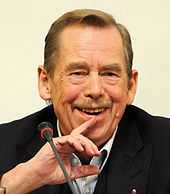
The Czech Republic is a pluralist multi-party parliamentary representative democracy, with the Prime Minister as the head of government. The Parliament (Parlament České republiky) is bicameral, with the Chamber of Deputies (Czech: Poslanecká sněmovna) (200 members) and the Senate (Czech: Senát) (81 members).
From 1993 through 2012, the President of the Czech Republic was selected by a joint session of the parliament for a five-year term, with no more than two consecutive terms. Since 2013 the presidential election is direct. The president is a formal head of state with limited specific powers, most importantly to return bills to the parliament, appoint members of a board of the Czech National Bank, nominate constitutional court judges for the Senate's approval and dissolve the Chamber of Deputies under certain special and unusual circumstances. He also appoints the prime minister, as well the other members of the cabinet on a proposal by the prime minister. From 2013 on, the president is elected by the public, not the parliament.[48] Miloš Zeman was the first directly elected Czech President.
The Prime Minister is the head of government and wields considerable powers, such as the right to set the agenda for most foreign and domestic policy and choose government ministers.
The members of the Chamber of Deputies are elected for a four-year term by proportional representation, with a 5% election threshold. There are 14 voting districts, identical to the country's administrative regions. The Chamber of Deputies, the successor to the Czech National Council, has the powers and responsibilities of the now defunct federal parliament of the former Czechoslovakia.
The members of the Senate are elected in single-seat constituencies by two-round runoff voting for a six-year term, with one-third elected every even year in the autumn. The first election was in 1996, for differing terms. This arrangement is modeled on the U.S. Senate, but each constituency is roughly the same size and the voting system used is a two-round runoff. The Senate is unpopular among the public and suffers from low election turnout.
Foreign relations
Membership in the European Union is central to the Czech Republic's foreign policy. The Czech Republic held the Presidency of the Council of the European Union for the first half of 2009.
Czech officials have supported dissenters in Burma, Belarus, Moldova and Cuba.[49]
.jpg)
Military
The Czech armed forces consist of the Army, Air Force and of specialized support units. The President of the Czech Republic is Commander-in-chief of the armed forces. In 2004 the army transformed itself into a fully professional organization and compulsory military service was abolished. The country has been a member of NATO since 12 March 1999. Defense spending is approximately 1.8% of the GDP (2006). Currently, as a member of NATO, the Czech military are participating in ISAF and KFOR operations and have soldiers in Afghanistan and Kosovo. Main equipment includes: multi-role fighters JAS 39 Gripen, combat aircraft Aero L-159 Alca, modernized attack helicopters Mi-35, armored vehicles Pandur II, OT-64, OT-90, BVP-2 and Czech modernized tanks T-72 (T-72M4CZ).
Administrative divisions
Since 2000, the Czech Republic has been divided into thirteen regions (Czech: kraje, singular kraj) and the capital city of Prague. Every region has its own elected regional assembly (krajské zastupitelstvo) and hejtman (a regional governor). In Prague, the assembly and presidential powers are executed by the city council and the mayor.
The older seventy-six districts (okresy, singular okres) including three "statutory cities" (without Prague, which had special status) lost most of their importance in 1999 in an administrative reform; they remain as territorial divisions and seats of various branches of state administration.[50]
.png)
| Licence plate letter |
Region name in English |
Region name in Czech |
Administrative seat |
Population (2004 estimate) |
Population (2010 estimate) |
|---|---|---|---|---|---|
| A | |
Hlavní město Praha | n/a | 1,170,571 | 1,251,072 |
| S | |
Středočeský kraj | Prague (Praha)b | 1,144,071 | 1,256,850 |
| C | |
Jihočeský kraj | České Budějovice | 625,712 | 637,723 |
| P | |
Plzeňský kraj | Plzeň | 549,618 | 571,831 |
| K | |
Karlovarský kraj | Karlovy Vary | 304,588 | 307,380 |
| U | |
Ústecký kraj | Ústí nad Labem | 822,133 | 835,814 |
| L | |
Liberecký kraj | Liberec | 427,563 | 439,458 |
| H | |
Královéhradecký kraj | Hradec Králové | 547,296 | 554,370 |
| E | |
Pardubický kraj | Pardubice | 505,285 | 516,777 |
| M | |
Olomoucký kraj | Olomouc | 635,126 | 641,555 |
| T | |
Moravskoslezský kraj | Ostrava | 1,257,554 | 1,244,837 |
| B | |
Jihomoravský kraj | Brno | 1,123,201 | 1,152,819 |
| Z | |
Zlínský kraj | Zlín | 590,706 | 590,527 |
| J | |
Kraj Vysočina | Jihlava | 517,153 | 514,805 |
a Capital city.
b Office location.
Geography
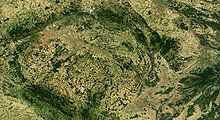
The Czech Republic lies mostly between latitudes 48° and 51° N (a small area lies north of 51°), and longitudes 12° and 19° E.
The Czech landscape is exceedingly varied. Bohemia, to the west, consists of a basin drained by the Elbe (Czech: Labe) and the Vltava rivers, surrounded by mostly low mountains, such as the Krkonoše range of the Sudetes. The highest point in the country, Sněžka at 1,602 m (5,256 ft), is located here. Moravia, the eastern part of the country, is also quite hilly. It is drained mainly by the Morava River, but it also contains the source of the Oder River (Czech: Odra).
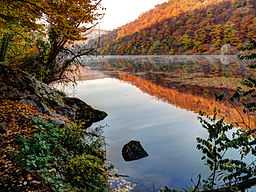
Water from the landlocked Czech Republic flows to three different seas: the North Sea, Baltic Sea and Black Sea. The Czech Republic also leases the Moldauhafen, a 30,000-square-metre (7.4-acre) lot in the middle of the Hamburg Docks, which was awarded to Czechoslovakia by Article 363 of the Treaty of Versailles, to allow the landlocked country a place where goods transported down river could be transferred to seagoing ships. The territory reverts to Germany in 2028.
Phytogeographically, the Czech Republic belongs to the Central European province of the Circumboreal Region, within the Boreal Kingdom. According to the World Wide Fund for Nature, the territory of the Czech Republic can be subdivided into four ecoregions: the Central European mixed forests, Pannonian mixed forests, Western European broadleaf forests and Carpathian montane conifer forests.
There are four national parks in the Czech Republic. The oldest is Krkonoše National Park (Biosphere Reserve), Šumava National Park (Biosphere Reserve), Podyjí National Park, Bohemian Switzerland.
Climate
The Czech Republic has a temperate continental climate, with warm summers and cold, cloudy and snowy winters. The temperature difference between summer and winter is relatively high, due to the landlocked geographical position.[51]
Within the Czech Republic, temperatures vary greatly, depending on the elevation. In general, at higher altitudes, the temperatures decrease and precipitation increases. The wettest area in the Czech Republic is found around Bílý Potok in Jizera Mountains and the driest region is the Louny District to the northwest of Prague. Another important factor is the distribution of the mountains; therefore, the climate is quite varied.
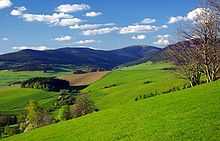
At the highest peak of Sněžka (1,602 m or 5,256 ft), the average temperature is only −0.4 °C (31 °F), whereas in the lowlands of the South Moravian Region, the average temperature is as high as 10 °C (50 °F). The country's capital, Prague, has a similar average temperature, although this is influenced by urban factors.
The coldest month is usually January, followed by February and December. During these months, there is usually snow in the mountains and sometimes in the major cities and lowlands. During March, April and May, the temperature usually increases rapidly, especially during April, when the temperature and weather tends to vary widely during the day. Spring is also characterized by high water levels in the rivers, due to melting snow with occasional flooding.
The warmest month of the year is July, followed by August and June. On average, summer temperatures are about 20 °C (68 °F) – 30 °C (86 °F) higher than during winter. Summer is also characterized by rain and storms.
Autumn generally begins in September, which is still relatively warm and dry. During October, temperatures usually fall below 15 °C (59 °F) or 10 °C (50 °F) and deciduous trees begin to shed their leaves. By the end of November, temperatures usually range around the freezing point.
The coldest temperature ever measured was in Litvínovice near České Budějovice in 1929, at −42.2 °C (−44.0 °F) and the hottest measured, was at 40.4 °C (104.7 °F) in Dobřichovice in 2012.[52]
Most rain falls during the summer. Sporadic rainfall is relatively constant throughout the year (in Prague, the average number of days per month experiencing at least 0.1 mm of rain varies from 12 in September and October to 16 in November) but concentrated heavy rainfall (days with more than 10 mm per day) are more frequent in the months of May to August (average around two such days per month).[53]
Environment
Czech Republic ranks as fifth most environmentally conscious country in the world in Environmental Performance Index.[54]
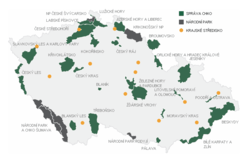
.jpg)

Economy
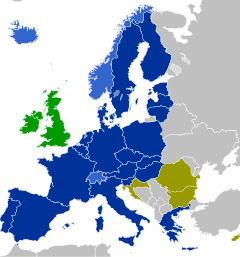
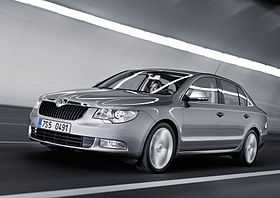
The Czech Republic possesses a developed,[55] high-income[56] economy with a per capita GDP rate that is 82% of the European Union average.[57] One of the most stable and prosperous of the post-Communist states, the Czech Republic saw growth of over 6% annually in the three years before the outbreak of the recent global economic crisis. Growth has been led by exports to the European Union, especially Germany, and foreign investment, while domestic demand is reviving.
Most of the economy has been privatised, including the banks and telecommunications. A 2009 survey in cooperation with the Czech Economic Association found that the majority of Czech economists favor continued liberalization in most sectors of the economy.[58]
The country is part of the Schengen Area from 1 May 2004, having abolished border controls, completely opening its borders with all of its neighbours, Germany, Austria, Poland and Slovakia, on 21 December 2007.[59] The Czech Republic became a member of the World Trade Organisation on 1 January 1995.
Monetary policy is conducted by the Czech National Bank, whose independence is guaranteed by the Constitution.[60] The official currency is the Czech crown, and it had been floating until 7. 11. 2013, when the central bank temporarily pegged the exchange rate at 27 crowns per euro in order to fight deflation.[61] When it joined EU, the Czech Republic obligated itself to adopt the euro, but the date of adoption has not been determined.
The Programme for International Student Assessment, coordinated by the OECD, currently ranks the Czech education system as the 15th best in the world, higher than the OECD average.[62] The Czech Republic is ranked 24th in the 2015 Index of Economic Freedom.
Leading Czech transportation companies include Škoda Auto (automobiles), Škoda Transportation (tramways, trolleybuses, metro), Tatra (the third oldest car maker in the world), Karosa (buses), Aero Vodochody (airplanes) and Jawa Motors (motorcycles). http://www.worlddiplomacy.org states that "Elections in 2013 brought a new government for the Czech Republic, however the economy continued to contract in 2013 but should be set to return to growth in 2014."[63]
Energy
Production of Czech electricity exceeds consumption by about 10 TWh per year, which are exported. Nuclear power presently provides about 30 percent of the total power needs, its share is projected to increase to 40 percent. In 2005, 65.4 percent of electricity was produced by steam and combustion power plants (mostly coal); 30 percent by nuclear plants; and 4.6 percent from renewable sources, including hydropower. The largest Czech power resource is Temelín Nuclear Power Station, another nuclear power plant is in Dukovany.
The Czech Republic is reducing its dependence on highly polluting low-grade brown coal as a source of energy. Natural gas is procured from Russian Gazprom, roughly three-fourths of domestic consumption and from Norwegian companies, which make up most of the remaining one-fourth. Russian gas is imported via Ukraine (Druzhba pipeline), Norwegian gas is transported through Germany. Gas consumption (approx. 100 TWh in 2003–2005) is almost double electricity consumption. South Moravia has small oil and gas deposits.
Transportation infrastructure
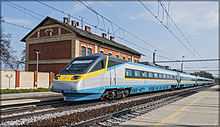
Václav Havel Airport in Prague is the main international airport in the country. In 2010, it handled 11.6 million passengers, which makes it the fifth busiest airport in Central and Eastern Europe. In total, the Czech Republic has 46 airports with paved runways, six of which provide international air services in Brno, Karlovy Vary, Mošnov (near Ostrava), Pardubice, Prague and Kunovice (near Uherské Hradiště).
České dráhy (the Czech railways) is the main railway operator in the Czech Republic, with about 180 million passengers carried yearly. Its cargo division, ČD Cargo, is the fifth largest railway cargo operator in the European Union. With 9,505 km (5,906.13 mi) of tracks, the Czech Republic has one of the densest railway networks in Europe.[64] Of that number, 2,926 km (1,818.13 mi) is electrified, 7,617 km (4,732.98 mi) are single-line tracks and 1,866 km (1,159.48 mi) are double and multiple-line tracks.[65] In 2006 the new Italian tilting trains Pendolino ČD Class 680 entered service. They have reached a speed of 237 km/h setting a new Czech railway speed record.
Russia, via pipelines through Ukraine and to a lesser extent, Norway, via pipelines through Germany, supply the Czech Republic with liquid and natural gas.
The road network in the Czech Republic is 55,653 km (34,581.17 mi) long.[66] There are 738,4 km of motorways and 439,1 km of expressways.[67] The speed limit is 50 km/h within towns, 90 km/h outside of towns and 130 km/h on expressways.
Communications
The Czech Republic ranks in the top 10 countries worldwide with the fastest average internet speed.[68] The Czech Republic has the most Wi-Fi subscribers in the European Union.[69][70] By the beginning of 2008, there were over 800 mostly local WISPs,[71][72] with about 350,000 subscribers in 2007. Plans based on either GPRS, EDGE, UMTS or CDMA2000 are being offered by all three mobile phone operators (T-Mobile, Telefónica O2, Vodafone) and internet provider U:fon. Government-owned Český Telecom slowed down broadband penetration. At the beginning of 2004, local-loop unbundling began and alternative operators started to offer ADSL and also SDSL. This and later privatisation of Český Telecom helped drive down prices.
On 1 July 2006, Český Telecom was acquired by globalized company (Spain owned) Telefónica group and adopted new name Telefónica O2 Czech Republic. As of June 2014, VDSL and ADSL2+ are offered in many variants, with download speeds of up to 40 Mbit/s and upload speeds of up to 2Mbit/s. Cable internet is gaining popularity with its higher download speeds ranging from 2 Mbit/s to 240 Mbit/s.
Science and technology
The Czech lands have a long and rich scientific tradition. The research based on cooperation between universities, Academy of Sciences and specialised research centers brings new inventions and impulses in this area. Important inventions include the modern contact lens, the separation of modern blood types, and the production of the Semtex plastic explosive. In March 1978, Czechoslovakian Vladimír Remek was the first person outside of the Soviet Union and the United States to go into space.
Prominent scientists who lived and worked in historically Czech lands include:
- John Amos Comenius (1592–1670), teacher, educator and the founder of modern education.[73]
- Václav Prokop Diviš (1698–1765), inventor of the first grounded lightning rod.
- Bernard Bolzano (1781–1848), noted mathematician, logician, philosopher, and pacifist.
- Jan Evangelista Purkyně (1787–1869), anatomist and physiologist responsible for the discovery of Purkinje cells, Purkinje fibres and sweat glands, as well as Purkinje images and the Purkinje shift.
- Josef Ressel (1793–1857), inventor of the screw propeller and modern compass.[73]
- Jakub Kryštof Rad (1799–1871), inventor of sugar cubes.
- Gregor Mendel (1822–1884), often called the "father of genetics", is famed for his research concerning the inheritance of genetic traits.[73]
- Jakub Husník (1837–1916), improved the process of photolithography.
- Karel Klíč (1841–1926), painter and photographer, inventor of the photogravure.
- František Křižík (1847–1941), electrical engineer, inventor of the arc lamp.
- Jan Janský (1873–1921), serologist and neurologist, discovered the ABO blood groups.
- Bedřich Hrozný (1879–1952), deciphered the Hittite language.[73]
- Josef Čapek (1887–1945) and Karel Čapek (1890–1938), brothers who originated the word robot.
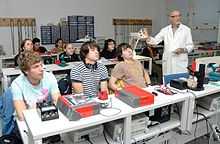 Lecture at the Faculty of Biomedical Engineering, CTU, in Prague.
Lecture at the Faculty of Biomedical Engineering, CTU, in Prague. - František Burian and Arnold Jirásek, founded the first plastic surgery in 1927.[74]
- Jaroslav Heyrovský (1890–1967), inventor of polarography, electroanalytical chemistry and recipient of the Nobel Prize.[73]
- Oldřich Homuta, inventor of Remoska oven in 1957.
- Otto Wichterle (1913–1998) and Drahoslav Lím (1925–2003), Czech chemists responsible for the invention of the modern contact lens and silon (synthetic fiber).[75]
- Stanislav Brebera (1925–2012), inventor of the plastic explosive Semtex in 1966.[76]
- Ladislav Mareš, inventor of the first machine producing nanofibres, "Nanospider".[77]
- Antonín Holý (1936–2012), scientist and chemist, in 2009 was involved in creation of the most effective drug in the treatment of AIDS.[78]
A number of other scientists are also connected in some way with the Czech lands, including astronomers Johannes Kepler and Tycho Brahe, the founder of the psychoanalytic school of psychiatry Sigmund Freud, physicists Christian Doppler, Ernst Mach, Nikola Tesla, Albert Einstein, engineer Viktor Kaplan and logician Kurt Gödel.
Tourism

The Czech economy gets a substantial income from tourism. In 2011, Prague was the sixth most visited city in Europe.[79] In 2001, the total earnings from tourism reached 118 billion CZK, making up 5.5% of GNP and 9% of overall export earnings. The industry employs more than 110,000 people – over 1% of the population.[80] The country's reputation has suffered with guidebooks and tourists reporting overcharging by taxi drivers and pickpocketing problems mainly in Prague.[81][82] Since 2005, Prague's mayor, Pavel Bém, has worked to improve this reputation by cracking down on petty crime[82] and, aside from these problems, Prague is a safe city.[83] Also, the Czech Republic as a whole generally has a low crime rate.[84] For tourists, the Czech Republic is considered a safe destination to visit. The low crime rate makes most cities and towns safe to walk around even after dark.
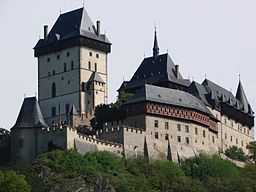
There are several centres of tourist activity. The spa towns, such as Karlovy Vary, Mariánské Lázně and Františkovy Lázně and Jáchymov (very high radioactivity), are particularly popular relaxing holiday destinations. Architectural heritage is another object of visitor´s interest – it includes many castles and chateaux from different historical epoques, namely Karlštejn Castle, Český Krumlov and the Lednice–Valtice area. There are 12 cathedrals and 15 churches elevated to the rank of basilica by the Pope, calm monasteries, many modern and ancient churches – for example Pilgrimage Church of Saint John of Nepomuk is one of those inscribed on the World Heritage List. Away from the towns, areas such as Český ráj, Šumava and the Krkonoše Mountains attract visitors seeking outdoor pursuits.
The country is also known for its various museums, very popular are puppetry and marionettes exhibitions with a number of puppet festivals throughout the country. Aquapalace Praha in Čestlice near Prague, is the biggest water park in central Europe.[85]
The Czech Republic has a number of beer festivals, including: Czech Beer Festival (the biggest Czech beer festival, it is 17 days long and held every year in May in Prague), Pilsner Fest (every year in August in Plzeň), The "Olomoucký pivní festival" (in Olomouc) or festival "Slavnosti piva v Českých Budějovicích" (in České Budějovice).
Demographics
| Rank | City | Region | Population [86] | Metropolitan area | ||||||
|---|---|---|---|---|---|---|---|---|---|---|
| 1 | Prague | Prague, the Capital City | 1,268,796 | 2,300,000 | ||||||
| 2 | Brno | South Moravian | 385,913 | 729,510 | ||||||
| 3 | Ostrava | Moravian-Silesian | 304 357 | 1,164,328 | ||||||
| 4 | Plzeň | Plzeň | 170,322 | 380,000 | ||||||
| 5 | Liberec | Liberec | 102,754 | 270,000 | ||||||
| 6 | Olomouc | Olomouc | 101,003 | 480,000[87] | ||||||
| 7 | Hradec Králové | Hradec Králové | 94,314 | - | ||||||
| 8 | České Budějovice | South Bohemian | 93,715 | 190,000[88] | ||||||
| 9 | Ústí nad Labem | Ústí nad Labem | 93,000 | - | ||||||
| 10 | Pardubice | Pardubice | 90,767 | - | ||||||
| 11 | Havířov | Moravian-Silesian | 76,694 | - | ||||||
| 12 | Zlín | Zlín | 75,318 | 450 000 | ||||||
| 13 | Kladno | Central Bohemian | 68,103 | - | ||||||
| 14 | Most | Ústí nad Labem | 65,193 | 95,316 | ||||||
| 15 | Opava | Moravian-Silesian | 58,351 | - | ||||||
| 16 | Karviná | Moravian-Silesian | 56,897 | - | ||||||
| 17 | Frýdek-Místek | Moravian-Silesian | 56,356 | - | ||||||
| 18 | Jihlava | Vysočina | 50,075 | - | ||||||
| 19 | Děčín | Ústí nad Labem | 49,106 | - | ||||||
| 20 | Karlovy Vary | Karlovy Vary | 48,639 | - | ||||||
| Historical population | ||
|---|---|---|
| Year | Pop. | ±% |
| 1857 | 7,016,531 | — |
| 1869 | 7,617,230 | +8.6% |
| 1880 | 8,222,013 | +7.9% |
| 1890 | 8,665,421 | +5.4% |
| 1900 | 9,372,214 | +8.2% |
| 1910 | 10,078,637 | +7.5% |
| 1921 | 10,009,587 | −0.7% |
| 1930 | 10,674,386 | +6.6% |
| 1950 | 8,896,133 | −16.7% |
| 1961 | 9,571,531 | +7.6% |
| 1970 | 9,807,697 | +2.5% |
| 1980 | 10,291,927 | +4.9% |
| 1991 | 10,302,215 | +0.1% |
| 2001 | 10,230,060 | −0.7% |
| 2011 | 10,436,560 | +2.0% |
| 2014 | 10,528,477 | +0.9% |
According to preliminary results of the 2011 census, the majority of the inhabitants of the Czech Republic are Czechs (63.7%), followed by Moravians (4.9%), Slovaks (1.4%), Poles (0.4%), Germans (0.2%) and Silesians (0.1%). As the 'nationality' was an optional item, a substantial number of people left this field blank (26.0%).[89] According to some estimates, there are about 250,000 Romani people in the Czech Republic.[90][91]
There were 437,581 foreigners residing in the country in September 2013, according to the Czech Statistical Office,[92] with the largest groups being Ukrainian (106,714), Slovak (89,273), Vietnamese (61,102), Russian (32,828), Polish (19,378), German (18,099), Bulgarian (8,837), American (6,695), Romanian (6,425), Moldovan (5,860), Chinese (5,427), British (5,413), Mongolian (5,308), Kazakh (4,850), Belarusian (4,562).[92]
The Jewish population of Bohemia and Moravia, 118,000 according to the 1930 census, was virtually annihilated by the Nazi Germans during the Holocaust.[93] There were approximately 4,000 Jews in the Czech Republic in 2005.[94] The former Czech prime minister, Jan Fischer, is of Jewish origin and faith.[95]
The total fertility rate (TFR) in 2013 was estimated at 1.29 children born/woman, which is below the replacement rate of 2.1, and one of the lowest in the world.[96] In 2014, 46.7% of births were to unmarried women.[97] The life expectancy in 2013 was estimated at 77.56 years (74.29 years male, 81.01 years female).[96] Immigration increased the population by almost 1% in 2007. About 77,000 people immigrate to the Czech Republic annually.[98] Vietnamese immigrants began settling in the Czech Republic during the Communist period, when they were invited as guest workers by the Czechoslovak government.[99] In 2009, there were about 70,000 Vietnamese in the Czech Republic.[100] Most decide to stay in the country permanently.[101]
At the turn of the 20th century, Chicago was the city with the third largest Czech population,[102] after Prague and Vienna.[103] According to the 2010 US census, there are 1,533,826 Americans of full or partial Czech descent.[104]
Religion
The Czech Republic has one of the least religious populations in the world, being the country with the third most atheistic population by percentage, behind only China and Japan.[106] Historically, the Czech people have been characterised as "tolerant and even indifferent towards religion".[107] According to the 2011 census, 34% of the population stated they had no religion, 10.3% was Roman Catholic, 0.8% was Protestant (0.5% Czech Brethren and 0.4% Hussite), and 9% followed other forms of religion both denominational or not (of which 863 people answered they are Pagan). 45% of the population did not answer the question about religion.[105] From 1991 to 2001 and further to 2011 the adherence to Roman Catholicism decreased from 39% to 27% and then to 10%; Protestantism similarly declined from 3.7% to 2% and then to 0.8%.[108]
According to a Eurobarometer Poll in 2010,[109] 16% of Czech citizens responded that "they believe there is a God" (the lowest rate among the countries of the European Union),[110] whereas 44% answered that "they believe there is some sort of spirit or life force" and 37% said that "they do not believe there is any sort of spirit, God or life force".
Culture
Art
The Czech Republic is known worldwide for its individually made, mouth blown and decorated art glass and crystal. One of the best Czech painters and decorative artists was Alphonse Mucha (1860–1939) mainly known for art nouveau posters and his cycle of 20 large canvases named the Slav Epic, which depicts the history of Czechs and other Slavs. As of 2012, the Slav Epic can be seen in Veletržní Palace of National Gallery in Prague, which manages the largest collection of art in the Czech Republic.
Other notable Czech artists include:
- Max Švabinský (1873–1962) – painter, illustrator, abstract art
- Emil Filla (1882–1953) – painter, cubism
- Josef Čapek (1887–1945) – painter, cubism
- Bohumil Kubišta (1884–1918) – painter, cubism
- Václav Špála (1885–1945) – painter, cubism
- František Kupka (1871–1954) – painter, abstract art
- Jan Zrzavý (1890–1977) – painter, graphic artist, illustrator
- Karel Teige (1900–1951) – painter, illustrator, surrealism
- Toyen (1902–1980) – painter, illustrator, surrealism
- Jiří Anderle (1936) – graphic artist
Architecture
Literature
Czech literature is the literature written by Czechs, mostly in the Czech language, although other languages like Old Church Slavonic, Latin or German have been also used, such as by author Franz Kafka, who—while bilingual in Czech and German[111][112]—wrote his works in German, during the era of Austrian rule.
Influential Czech authors who wrote in Latin include Cosmas of Prague († 1125), Peter of Zittau († 1339), John Hus († 1415), Bohuslav Hasištejnský z Lobkovic (1461–1510), Jan Dubravius (1486–1553), Tadeáš Hájek (1525–1600), Johannes Vodnianus Campanus (1572–1622), and Bohuslav Balbín (1621–1688). In the late 13th century the royal court in Prague was one of the centers of German Minnesang. The most famous Czech medieval German-language work is the Ploughman of Bohemia (Der Ackermann aus Böhmen), written around 1401 by Johannes von Tepl. The heyday of Czech German-language literature can be seen in the first half of the 20th century, which is represented by the well-known names of Franz Kafka, Max Brod, Franz Werfel, Rainer Maria Rilke, Egon Erwin Kisch, and others.
The Bible translations played an important role in the development of Czech literature and standard Czech language. The oldest Czech translation of the Psalms originated in the late 13th century and the first Czech translation of the whole Bible was finished around 1360. The first complete printed Czech Bible was published in 1488 (Prague Bible). The first complete Czech Bible translation from original languages was published between 1579–93 and is known as the Bible of Kralice.
Czech-language literature can be divided into several main time periods: the Middle Ages (Chronicle of Dalimil); the Hussite period (Tomáš Štítný ze Štítného, Jan Hus, Petr Chelčický); the Renaissance humanism (Henry the Younger of Poděbrady, Luke of Prague, Wenceslaus Hajek, Jan Blahoslav, Daniel Adam z Veleslavína); the Baroque period (John Amos Comenius, Adam Václav Michna z Otradovic, Bedřich Bridel, Jan František Beckovský); the Enlightenment and Czech reawakening in the 19th century (Václav Matěj Kramerius, Karel Hynek Mácha, Karel Jaromír Erben, Karel Havlíček Borovský, Božena Němcová, Jan Neruda, Alois Jirásek); the avant-garde of the interwar period (Karel Čapek, Jaroslav Hašek, Vítězslav Nezval, Jaroslav Seifert, Bohuslav Reynek); the years under Communism and the Prague Spring (Josef Škvorecký, Bohumil Hrabal, Milan Kundera, Arnošt Lustig, Václav Havel); and the literature of the post-Communist Czech Republic (Ivan Martin Jirous).
Jaroslav Seifert was the only Czech writer awarded the Nobel Prize in Literature. A famous antiwar comedy novel The Good Soldier Švejk by Jaroslav Hašek is the most translated Czech book in history. It was depicted by Karel Steklý in two color films The Good Soldier Schweik in 1956 and 1957.
Czech literature and culture played a major role on at least two occasions, when Czechs lived under oppression and political activity was suppressed. On both of these occasions, in the early 19th century and then again in the 1960s, the Czechs used their cultural and literary effort to strive for political freedom, establishing a confident, politically aware nation.
Music
Music in the Czech lands has its roots in more than 1,000-year-old sacred music. The first surviving references Lord, Have Mercy on Us come from the end of the 10th century and in the traditional folk music of Bohemia, Moravia and Silesia and in the long-term high-culture classical music tradition. Since the early eras of artificial music, Czech musicians and composers have often been influenced by genuine folk music (such as polka which originated in Bohemia). Notable Czech composers include Antonín Dvořák, Bedřich Smetana, Gustav Mahler (he was born and grew up in the Czech lands), Adam Michna, Jan Dismas Zelenka, Josef Mysliveček, Leoš Janáček, Josef Suk, Bohuslav Martinů, Erwin Schulhoff and Petr Eben.
Theatre
Theatre of the Czech Republic has rich tradition with roots in the Middle Ages. In the 19th century, the theatre played an important role in the national awakening movement and later, in the 20th century it became a part of the modern European theatre art.
Film
The Barrandov Studios in Prague are the largest film studios in country and one of the largest in Europe. The Czech Republic has many popular film locations.[113] Filmmakers have come to Prague to shoot scenery no longer found in Berlin, Paris and Vienna. The city of Karlovy Vary was used as a location for the 2006 James Bond film Casino Royale.[114] Czech Lion is the highest award for Czech film achievement. The international Karlovy Vary film festival is one of the oldest in the world.
Video games
Video games are considered by some experts to be the biggest cultural export of the country. There are some globally successful video game developers based in the Czech Republic such as Bohemia Interactive, Keen Software House, Illusion Softworks, Amanita Design or Madfinger Games. Video games produced in the Czech Republic include Space Engineers, Machinarium, Operation Flashpoint: Cold War Crisis, ARMA 3, Mafia: The City of Lost Heaven, Mafia 2, Vietcong, Machinarium, Shadowgun and DayZ.[115]
Czech Video Games have been annually Awarded by Czech Game of the Year Awards since 2010. Awards are held at Anifilm.
Cuisine
Czech cuisine is marked by a strong emphasis on meat dishes. Pork is quite common; beef and chicken are also popular. Goose, duck, rabbit and wild game are served. Fish is rare, with the occasional exception of fresh trout and carp, which is served at Christmas.
Czech beer has a long and important history. The first brewery is known to have existed in 1118 and the Czech Republic has the highest beer consumption per capita in the world. The famous pilsner style beer originated in the western Bohemian city of Plzeň, where world famous Pilsner Urquell is still being produced, and further south the town of České Budějovice, known as Budweis in German, lent its name to its beer, eventually known as Budweiser Budvar. Apart from these and other major brands, the Czech Republic also boasts a growing number of top quality small breweries and mini-breweries seeking to continue the age-old tradition of quality and taste, whose output matches the best in the world: Štiřín, Chýně, Oslavany, Kácov. Tourism is slowly growing around the Southern Moravian region too, which has been producing wine since the Middle Ages; about 94% of vineyards in the Czech Republic are Moravian. Aside from slivovitz, Czech beer and wine, the Czechs also produce two unique liquors, Fernet Stock and Becherovka. Kofola is a non-alcoholic domestic cola soft drink which competes with Coca Cola and Pepsi in popularity.
Some popular Czech dishes include:
- Vepřo-knedlo-zelo: roast pork with bread dumplings and stewed cabbage
- svíčková na smetaně: roast sirloin of beef with steamed dumplings and cream of vegetable sauce
- Rajská: beef in tomato sauce, traditionally served with dumplings
- Koprovka: beef in dill sauce, traditionally served with dumplings
- roast duck with bread or potato dumplings and braised red cabbage
- guláš: a variety of beef and pork goulash stews, served with dumplings or bread
- smažák: fried cheese, typically served with potatoes, french fries, etc.
- bramboráky: potato pancakes, traditionally served with sour cabbage
There is also a large variety of local sausages, wurst, pâtés, and smoked and cured meats. Czech desserts include a wide variety of whipped cream, chocolate, and fruit pastries and tarts, crepes, creme desserts and cheese, poppy seed filled and other types of traditional cakes such as buchty, koláče and štrúdl.
Sports
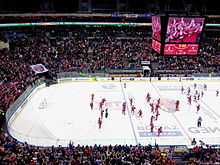
Sports play a part in the life of many Czechs, who are generally loyal supporters of their favorite teams or individuals. The three leading sports in the Czech Republic are ice hockey, football and shooting,[117] with the first two drawing the most attention from both the media and supporters. Tennis is also a very popular sport in the Czech Republic. The many other sports with professional leagues and structures include basketball, volleyball, team handball, track and field athletics and floorball. The Czech ice hockey team won the gold medal at the 1998 Winter Olympics and has won six gold medals at the World Championships, including three straight from 1999 to 2001. In total the country has won 14 gold medals in summer (plus 49 as Czechoslovakia) and five gold medals (plus two as Czechoslovakia) in winter Olympic history.
Sport is a source of strong waves of patriotism, usually rising several days or weeks before an event. The events considered the most important by Czech fans are: the Ice Hockey World Championships, Olympic Ice hockey tournament, UEFA European Football Championship, UEFA Champions League, FIFA World Cup and qualification matches for such events.[118] In general, any international match of the Czech ice hockey or football national team draws attention, especially when played against a traditional rival.
The Czech Republic also has great influence in tennis, with such players as Ivan Lendl, 8 times Grand Slam singles champion, 2010 Wimbledon Championships – Men's Singles finalist Tomáš Berdych, 2011 and 2014 Wimbledon Championships – Women's Singles champion Petra Kvitová, 1998 Wimbledon Women's Singles title Jana Novotná, 2011 Wimbledon Championships – Women's Doubles champion Květa Peschke and 18 time Grand Slam champion Martina Navratilova.
The favourite Czech individual or group sport is hiking, mainly in the Czech mountains. The word "tourist" in the Czech language also means a trekker or hiker. For beginners, thanks to the more than 100 years long tradition, there is a unique system of waymarking, one of the best in Europe. There is a network of around 40,000 km of perfectly marked short and long distance trails crossing the whole country and all the Czech mountains – not only in the Šumava Mountains, but also in the Vysočina, Krušné hory, Jizerské hory, Beskydy, Jeseníky, Orlické hory and Giant Mountains – Krkonoše.
See also
References
- Notes
- ↑ "Czech language". Czech Republic – Official website. Ministry of Foreign Affairs of the Czech Republic. Retrieved 14 November 2011.
- ↑ Citizens belonging to minorities, which traditionally and on a long-term basis live within the territory of the Czech Republic, enjoy the right to use their language in communication with authorities and in courts of law (for the list of recognized minorities see National Minorities Policy of the Government of the Czech Republic, Belorussian and Vietnamese since 4 July 2013, see Česko má nové oficiální národnostní menšiny. Vietnamce a Bělorusy). Article 25 of the Czech Charter of Fundamental Rights and Basic Freedoms ensures the right of the national and ethnic minorities to education and communication with the authorities in their own language. Act No. 500/2004 Coll. (The Administrative Rule) in its paragraph 16 (4) (Procedural Language) ensures that a citizen of the Czech Republic who belongs to a national or an ethnic minority, which traditionally and on a long-term basis lives within the territory of the Czech Republic, has the right to address an administrative agency and proceed before it in the language of the minority. If the administrative agency has no employee with knowledge of the language, the agency is bound to obtain a translator at the agency's own expense. According to Act No. 273/2001 (Concerning the Rights of Members of Minorities) paragraph 9 (The right to use language of a national minority in dealing with authorities and in front of the courts of law) the same also applies to members of national minorities in the courts of law.
- ↑ The Slovak language may be considered an official language in the Czech Republic under certain circumstances, as defined by several laws – e.g. law 500/2004, 337/1992. Source: http://portal.gov.cz. Cited: "Například Správní řád (zákon č. 500/2004 Sb.) stanovuje: "V řízení se jedná a písemnosti se vyhotovují v českém jazyce. Účastníci řízení mohou jednat a písemnosti mohou být předkládány i v jazyce slovenském ..." (§16, odstavec 1). Zákon o správě daní a poplatků (337/1992 Sb.) "Úřední jazyk: Před správcem daně se jedná v jazyce českém nebo slovenském. Veškerá písemná podání se předkládají v češtině nebo slovenštině ..." (§ 3, odstavec 1). http://portal.gov.cz
- ↑ "Czech Republic Population 2014". World Population Review. Retrieved 14 April 2014.
- ↑ "Population". Czech Statistical Office. 30 September 2014. Retrieved 21 March 2015.
- ↑ Census of Population and Housing 2011: Basic final results. Czech Statistical Office. Retrieved on 19 December 2012.
- ↑ 7.0 7.1 7.2 7.3 "Czech Republic". International Monetary Fund. Retrieved 14 April 2015.
- ↑ "Gini coefficient of equivalised disposable income (source: SILC)". Eurostat Data Explorer. Retrieved 13 August 2013.
- ↑ "Human Development Report 2011". United Nations. 2011. Retrieved 5 November 2011.
- ↑ "Oxford English Dictionary". Retrieved 13 September 2014.
- ↑ Mlsna, Petr; Šlehofer, F.; Urban, D. (2010). "The Path of Czech Constitutionality" (PDF). 1st edition (in : (Bilingual) – Czech and English). Praha: Úřad Vlády České Republiky (The Office of the Government of the Czech Republic). pp. 10–11. Retrieved 31 October 2012.
- ↑ Čumlivski, Denko (2012). "800 let Zlaté buly sicilské" (in Czech). National Archives of the Czech Republic (Národní Archiv České Republiky). Archived from the original on 1 October 2012. Retrieved 31 October 2012.
- ↑ 13.0 13.1 Velinger, Jan (28 February 2006). "World Bank Marks Czech Republic's Graduation to 'Developed' Status". Radio Prague. Retrieved 22 January 2007.
- ↑ "Edit/Review Countries". Imf.org. 14 September 2006. Retrieved 14 May 2014.
- ↑ Country and Lending Groups. World Bank. Accessed on 3 July 2014.
- ↑ http://www.imf.org/external/pubs/ft/weo/2014/01/pdf/text.pdf
- ↑ "Quality of Life Index by Country 2014 Mid Year". Retrieved 13 September 2014.
- ↑ Social Progress Index
- ↑ "2011 Human Development Report" (PDF). Retrieved 13 September 2014.
- ↑ "Oxford English Dictionary". Askoxford.com. Retrieved 4 March 2011.
- ↑ Czech. CollinsDictionary.com. Collins English Dictionary – Complete & Unabridged 11th Edition. Retrieved 19 November 2012.
- ↑ Spal, Jaromír. "Původ jména Čech". Naše řeč. Retrieved 10 December 2012.
- ↑ "Name Checkmate: Czecho, Czechia or . . . Czechland?". Los Angeles Times. 3 January 1993. Retrieved 28 November 2014.
- ↑ "Czech out the proposed name – Features – The Prague Post". Praguepost.cz. 16 October 2013. Retrieved 14 May 2014.
- ↑ "Meeting with the members of the Diplomatic Corps". www.hrad.cz. Prague Castle. October 29, 2014. Retrieved 27 April 2015.
- ↑ "Speech of the President of the Czech Republic during the Czech–Romanian business seminar". www.hrad.cz. Prague Castle. May 20, 2014. Retrieved 27 April 2015.
- ↑ "What's in a name? Czech Republic mulls shock rebranding as Czechia". The Independent. October 11, 2013. Retrieved 27 April 2015.
- ↑ Angi 1997, p. 360.
- ↑ Jan Dugosz, Maurice Michael (1997) The Annals of Jan Dlugosz, IM Publications, ISBN 1-901019-00-4
- ↑ "The rise and fall of the Przemyslid Dynasty". Archiv.radio.cz. Retrieved 25 April 2010.
- ↑ "Václav II. český král". panovnici.cz.
- ↑ "The flowering and the decline of the Czech medieval state". Arts.gla.ac.uk. Retrieved 25 April 2010.
- ↑ "Plague epidemics in Czech countries". E. Strouhal. p.49.
- ↑ Oskar Krejčí, Martin C. Styan, Ústav politických vied SAV. (2005). Geopolitics of the Central European region: the view from Prague and Bratislava. p.293. ISBN 80-224-0852-2
- ↑ "RP's History Online – Habsburgs". Archiv.radio.cz. Retrieved 25 April 2010.
- ↑ "History of the Mongols from the 9th to the 19th Century. Part 2. The So-Called Tartars of Russia and Central Asia. Division 1". Henry Hoyle Howorth. p.557. ISBN 1-4021-7772-0
- ↑ "The new Cambridge modern history: The ascendancy of France, 1648–88". Francis Ludwig Carsten (1979). p.494. ISBN 0-521-04544-4
- ↑ "The Cambridge economic history of Europe: The economic organization of early modern Europe". E. E. Rich, C. H. Wilson, M. M. Postan (1977). p.614. ISBN 0-521-08710-4
- ↑ "Radio Praha – zprávy". Retrieved 13 September 2014.
- ↑ "Tab. 3 Národnost československých státních příslušníků podle žup a zemí k 15.2.1921" (PDF) (in Czech). Czech Statistical Office. Archived from the original (PDF) on 5 June 2007. Retrieved 2 June 2007.
- ↑ "Ekonomika ČSSR v letech padesátých a šedesátých". Blisty.cz. 21 August 1968. Retrieved 14 May 2014.
- ↑ Gerhard L. Weinberg, The Foreign Policy of Hitler's Germany: Starting World War II, 1937–1939 (Chicago, 1980), pp. 470–481.
- ↑ Stephen A. Garrett (1996). "Conscience and power: an examination of dirty hands and political leadership". Palgrave Macmillan. p.60. ISBN 0-312-15908-0
- ↑ "A Companion to Russian History". Abbott Gleason (2009). Wiley-Blackwell. p.409. ISBN 1-4051-3560-3
- ↑ F. Čapka: Dějiny zemí Koruny české v datech. XII. Od lidově demokratického po socialistické Československo – pokračování. Libri.cz (Czech)
- ↑ "Czech schools revisit communism". Retrieved 13 September 2014.
- ↑ "Human Development Report 2009" (PDF). UNDP.org. Retrieved 25 April 2010.
- ↑ "Klaus signs Czech direct presidential election implementing law". Czech Press Agency. 1 August 2012. Retrieved 7 November 2012.
- ↑ "Czechs with few mates". The Economist. 30 August 2007. Retrieved 25 April 2010.
- ↑ "The death of the districts". Retrieved 13 September 2014.
- ↑ R. Tolasz, Climate Atlas of the Czech Republic, Czech Hydrometeorological Institute, Prague, 2007. ISBN 80-244-1626-3, graphs 1.5 and 1.6
- ↑ "Czech absolute record temperature registered near Prague". České noviny. ČTK. Retrieved 20 August 2012.
- ↑ R. Tolasz, Climate Atlas of the Czech Republic, Czech Hydrometeorological Institute, Prague, 2007. ISBN 80-244-1626-3, graph 2.9.
- ↑ "Country Rankings". Yale. 25 January 2014. Retrieved 29 January 2014.
- ↑ www.mccanndigital.cz. "Getting to know Czech Republic". Retrieved 13 September 2014.
- ↑ "World Bank 2007". Web.worldbank.org. Retrieved 25 April 2010.
- ↑ "GDP per capita in PPS". Eurostat. Retrieved 19 March 2015.
- ↑ Stastny, Daniel (2010). "Czech Economists on Economic Policy: A Survey". Econ Journal Watch 7 (3): 275–287.
- ↑ "Czech Republic to join Schengen". The Prague Post. 13 December 2006. Archived from the original on 25 February 2008. Retrieved 8 October 2007.
- ↑ "Czech Republic 1993 (rev. 2013)". Constitute. Retrieved 29 April 2015.
- ↑ http://byznys.ihned.cz/c1-61176370-cnb-po-11-letech-zahajila-intervence-koruna-okamzite-spadla-na-ctyrlete-minimum
- ↑ "Range of rank on the PISA 2006 science scale" (PDF). OECD.org. Retrieved 25 April 2010.
- ↑ "Czech Republic – Truth Prevails". Retrieved 13 September 2014.
- ↑ "Transport infrastructure at regional level – Statistics explained". Epp.eurostat.ec.europa.eu. Retrieved 25 April 2010.
- ↑ "Railway Network in the Czech Republic". SZDC.cz. Retrieved 9 November 2010.
- ↑ (Czech) Roads and Motorways in the Czech Republic. RSD.cz (2009).
- ↑
- ↑ Lee Taylor (2 May 2012). "'State of the Internet' report reveals the fastest web speeds around the world". news.com.au. Retrieved 2 May 2012.
- ↑ 2007 WiFi survey EN
- ↑ "Openspectrum.info – Czech Republic". Volweb.cz. Retrieved 25 April 2010.
- ↑ "Wi-Fi: Poskytovatelé bezdrátového připojení". internetprovsechny.cz. Retrieved 17 March 2008.
- ↑ "Bezdrátové připojení k internetu". bezdratovepripojeni.cz. Retrieved 18 May 2008.
- ↑ 73.0 73.1 73.2 73.3 73.4 Ingenious inventions at the Wayback Machine (archived 24 March 2009). Czech.cz. Retrieved 3 March 2009.
- ↑ František Burian
- ↑ The History of Contact Lenses. Retrieved 3 March 2009.
- ↑ "Velikáni české vědy". Retrieved 1 November 2010.
- ↑ "Vynalezl stroje na nanovlákna. Teď svou firmu opouští". Byznys.lidovky.cz. Retrieved 14 May 2014.
- ↑ "Faces of the Presidency". eu2009.cz. EU2009.cz. Retrieved 8 January 2009.
- ↑ "Tomio Okamura: Praha je 6. nejnavštěvovanější město Evropy – Televize plná Prahy". Metropol.cz. Retrieved 27 May 2012.
- ↑ "Promotion Strategy of the Czech Republic in 2004–2010". Czech Tourism. Archived from the original on 28 March 2007. Retrieved 19 December 2006.
- ↑ "Prague sees significant dip in tourist numbers". Radio.cz. 21 April 2010. Retrieved 25 April 2010.
- ↑ 82.0 82.1 "Prague mayor goes undercover to expose the great taxi rip-off". The Independent. Retrieved 13 September 2014.
- ↑ "Tips on Staying Safe in Prague". Retrieved 13 September 2014.
- ↑ "Czech Republic – Country Specific Information". Retrieved 13 September 2014.
- ↑ "Aquapalace Praha bude největším aquaparkem ve střední Evropě". Konstrukce.cz. Retrieved 27 May 2012.
- ↑ "2011 census" (in Czech). Czech Statistical Office. Retrieved 1 June 2013.
- ↑ Nařízení vlády č. 212/1997, kterým se vyhlašuje závazná část územního plánu velkého územního celku Olomoucké aglomerace
- ↑ Územní plán velkého územního celku ČESKOBUDĚJOVICKÉ SÍDELNÍ AGLOMERACE,
- ↑ První předběžné výsledky Sčítání lidu, domů a bytů 2011: Obyvatelstvo podle národnosti podle krajů. (PDF) . Retrieved on 12 August 2012.
- ↑ "The History and Origin of the Roma". Romove.radio.cz. Retrieved 25 April 2010.
- ↑ Green, Peter S. (5 August 2001). "British Immigration Aides Accused of Bias by Gypsies". New York Times. Retrieved 25 April 2010.
- ↑ 92.0 92.1 Foreigners by type of residence, sex and citizenship, Czech Statistical Office, 30 September 2013
- ↑ "The Holocaust in Bohemia and Moravia". Ushmm.org. Retrieved 25 April 2010.
- ↑ "The Virtual Jewish Library". Retrieved 13 September 2014.
- ↑ "PM Fischer visits Israel". Radio Prague. 22 July 2009.
- ↑ 96.0 96.1 "The World Factbook". Cia.gov. Retrieved 14 May 2014.
- ↑ https://www.czso.cz/csu/czso/ari/population-change-4-quarter-2014-q91zsn7atp
- ↑ "Press: Number of foreigners in ČR up ten times since 1989". Prague Monitor. 11 November 2009.
- ↑ O'Connor, Coilin (29 May 2007). "Is the Czech Republic's Vietnamese community finally starting to feel at home?". Czech Radio. Retrieved 1 February 2008.
- ↑ "Crisis Strands Vietnamese Workers in a Czech Limbo". Retrieved 13 September 2014.
- ↑ "Foreigners working in the Czech Republic" at the Wayback Machine (archived 3 June 2009). Ministry of Foreign Affairs. July 2006.
- ↑ Czechs and Bohemians. Encyclopedia of Chicago.
- ↑ "Czech and Slovak roots in Vienna". wieninternational.at. Retrieved 13 September 2014.
- ↑ "Total ancestry reported". U.S. Census Bureau. Retrieved 13 July 2014.
- ↑ 105.0 105.1 "Population by religious belief and by municipality size groups" (PDF). Czech Statistical Office. Retrieved 23 April 2012.
- ↑ "GLOBAL INDEX OF RELIGION AND ATHEISM" (PDF). Retrieved 10 October 2013.
- ↑ Richard Felix Staar, Communist regimes in Eastern Europe, Issue 269, p. 90
- ↑ "Population by denomination and sex: as measured by 1921, 1930, 1950, 1991 and 2001 censuses" (PDF) (in Czech and English). Czech Statistical Office. Retrieved 9 March 2010.
- ↑ "Eurobarometer on Biotechnology 2010 – page 381" (PDF). Retrieved 1 February 2013.
- ↑ "Eurobarometer on Biotechnology 2010 – page 381" (PDF).
- ↑ Hawes 2008, p. 29.
- ↑ Sayer 1996, pp. 164–210.
- ↑ "KFTV". Wilmington Publishing and Information Ltd. Retrieved 26 October 2012.
- ↑ "Czech Film Commission – Karlovy Vary". Czech Film Commission. Retrieved 26 October 2012.
- ↑ Pros, Marek. "Videohry jsou největší kulturní export Česka, tvrdí odborník". Aktualne.cz.
- ↑ Reflex:
- ↑ Kyša, Leoš (28 January 2011). "Počet legálně držených zbraní v Česku stoupá. Už jich je přes 700 tisíc" (in Czech). ihned.cz. Retrieved 28 January 2011.
- ↑ "Prague's Most Popular Sports". Prague.fm. Retrieved 14 May 2014.
- Sources
- Angi, János (1997). "A nyugati szláv államok [=Western Slavic states]". In Pósán, László; Papp, Imre; Bárány, Attila; Orosz, István; Angi, János. Európa a korai középkorban ["Europe in the Early Middle Ages"]. Multiplex Media - Debrecen University Press. pp. 358–365. ISBN 963-04-9196-6.
Further reading
- Hochman, Jiří. Historical dictionary of the Czech State (1998)
External links
- Czech Republic entry at The World Factbook
- Czech Republic information from the United States Department of State
- Portals to the World from the United States Library of Congress
- Czech Republic at UCB Libraries GovPubs
- Czech Republic at DMOZ
- Czech Republic profile from the BBC News
 Wikimedia Atlas of the Czech Republic
Wikimedia Atlas of the Czech Republic Geographic data related to Czech Republic at OpenStreetMap
Geographic data related to Czech Republic at OpenStreetMap- Key Development Forecasts for the Czech Republic from International Futures
- Czech Republic
- History of Celts
- History of Czech Economic and Political Alignments Viewed as a Transition
- Government
- Governmental website
- Presidential website
- Portal of the Public Administration
- Senate
- Chief of State and Cabinet Members
- News
- Statistics
- Trade
- Travel
- Czech Tourism official travel site of the Czech Republic
- Czech tourist club official webpage
| ||||||||||||||||||||||||||||||||||||||
Coordinates: 49°45′N 15°30′E / 49.750°N 15.500°E

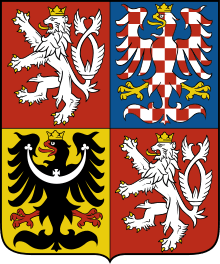
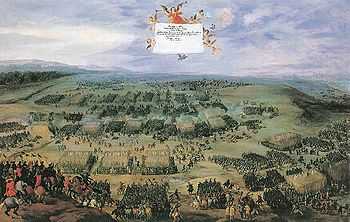

.jpg)

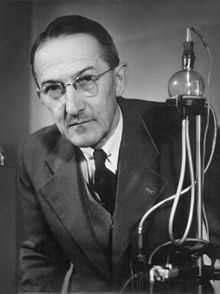
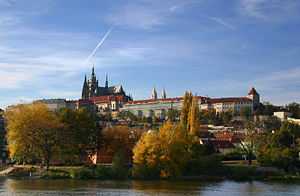
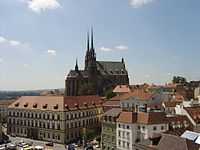

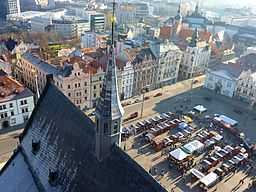
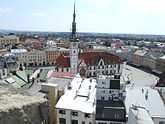
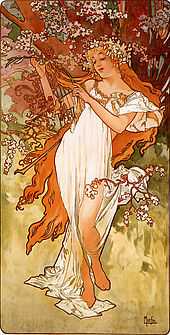
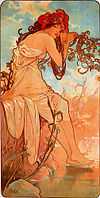
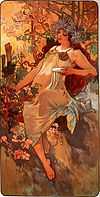
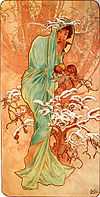
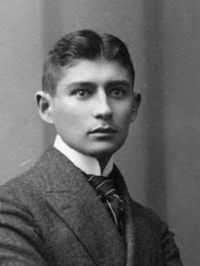
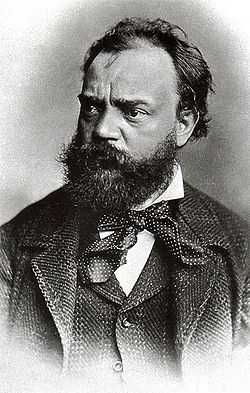
.svg.png)
